Isotopic Constraints on Earth System Processes. Группа авторов
Чтение книги онлайн.
Читать онлайн книгу Isotopic Constraints on Earth System Processes - Группа авторов страница 43
 0.91
0.91
Note: ∆44 Ca/40CaBSE‐SRM915a = δ44Ca/40CaBSE ‐ δ44Ca/40CaSRM915a
MC‐ICP‐MS methods obtain δ44 Ca/40Ca by multiplying δ44Ca/42Ca by a scaling factor. If not stated standard errors are estimated by multiplying those reported by 2.049.
* Value estimated by comparison of reported δ44Ca/40Ca of BHVO‐2 to that of Huang et al. (2011).
** Value estimated by comparison of reported δ44Ca/40Ca of SRM915b to that of Simon et al. (2017).
Figure 3.1 Maps of Central America, Eastern Africa, and Europe showing location of the studied samples. The location of the DSDP Site 495, off the coast of Guatemala, is also indicated
(Central American map modified from Patino et al., 2000).
Two fresh carbonatite lavas, collected immediately after eruptions in 2007 and 2008 from Oldoinyo Lengai volcano, Tanzania, were also selected for this study. Oldoinyo Lengai is located on the eastern branch of the East African Rift Valley and is the only modern extrusive carbonatite locality (Fig. 3.1). The sample from 2007 (OL lava 2007) is representative of the large volumes of rare, relatively Na‐rich (natro‐) carbonatite lavas extruded until August 2007. The younger lava (OL lava 4‐7‐08) was extruded at a time when Oldoinyo Lengai was erupting more silicic ashes (Fischer et al., 2009). Both samples were provided to me by T. Fisher.
The final sample was a clast of intrusive carbonatite from the Laacher See volcano, Germany. Laacher See volcano is located in the Late Pleistocene East Eifel Volcanic Field that is part of a series of intra‐plate volcanic fields in Central Europe (Fig. 3.1). The carbonatitic ejecta clast was extruded ~12.9 ka as part of the most recent episode of highly alkalic and silica‐undersaturated magmas (Schmitt et al., 2010; references therein). The material analyzed comes from a rounded nearly 100% sövite domain (~cm in size) associated with coarse‐grained calcite. The sample was provided by A. Schmitt who conducted an accessory mineral uranium‐series dating study to address the magmatic longevity of the most recent period of subvolcanic magmatism (Schmitt et al., 2010).
Figure 3.2 Regional variations in trace element ratios along the Central American volcanic arc. MORB‐like Ba/La and Ba/Th values occur in Honduras volcanoes whereas maximum values, believed to be tracers of hemipelagic sediment and marine carbonate, respectively, occur in western Nicaraguan volcanoes
(data from Patino et al., 1997, 2000).
3.3. RESULTS
All but one of the studied samples have δ44Ca values that are similar to the “normal” BSE composition (~0‰); see Fig. 3.3 and Table 3.1. Their calcium isotopic compositions are similar to the compositions of clinopyroxene‐rich and/or unmelted and unmetasomatized peridotites (Huang et al., 2010; Kang et al., 2017; Simon & DePaolo, 2010) and well‐studied oceanic and continental basalts, e.g., Bermingham et al. (2018), Huang et al. (2011), Simon and DePaolo (2010), and Simon et al. (2017), Table 3.1. Honduran sample YO‐1, which has MORB‐like Sr and Nd isotope and LILE/HFSE trace element ratios, exhibits a δ44Ca (–0.16 ± 0.14‰ [2σ]) that is similar to the samples from Nicaragua, TE1 (δ44Ca = –0.12 ± 0.14‰ [2σ]) and SC2 (δ44Ca = 0.06 ± 0.05‰ [2σ]) that have the most obvious trace element and radiogenic isotope signatures for sediment subduction (Fig. 3.4; Carr et al., 1990; Patino et al., 2000). The final Central American arc sample from Guatemala exhibits a similar calcium isotopic composition (δ44Ca = –0.08 ± 0.14‰ [2σ]). Likewise, both fresh Oldoinyo Lengai carbonatites OL lava 2007 (δ44Ca –0.13 ± 0.14‰ [2σ]) and OL Lava 4‐7‐08 (δ44Ca = 0.05 ± 0.13‰ [2σ]) have calcium isotope compositions that are similar to BSE. The exception in this study is the clast of intrusive carbonatite from the Laacher See volcano. The carbonatitic ejecta clast has a value that is lighter than BSE (δ44Ca = –0.39 ± 0.14‰ [2σ]).
Figure 3.3 Calcium isotopic composition of Central American volcanic arc magmas (this study), extrusive Oldoinyo Lengai carbonatite lavas (this study), and intrusive Laacher See carbonatite clast (this study). Values for unmelted/unmetamorphosed peridotites, komatiites, terrestrial basalts, seawater, marine carbonates, SRM915a carbonate, and the effect of metasomatism shown for reference (Amsellem et al., 2019; Antonelli et al. 2019a; Bermingham et al., 2018; Fantle & DePaolo, 2005; Huang et al., 2010, 2011; Ionov et al., 2019; Kang et al., 2017; Simon & DePaolo, 2010; Simon